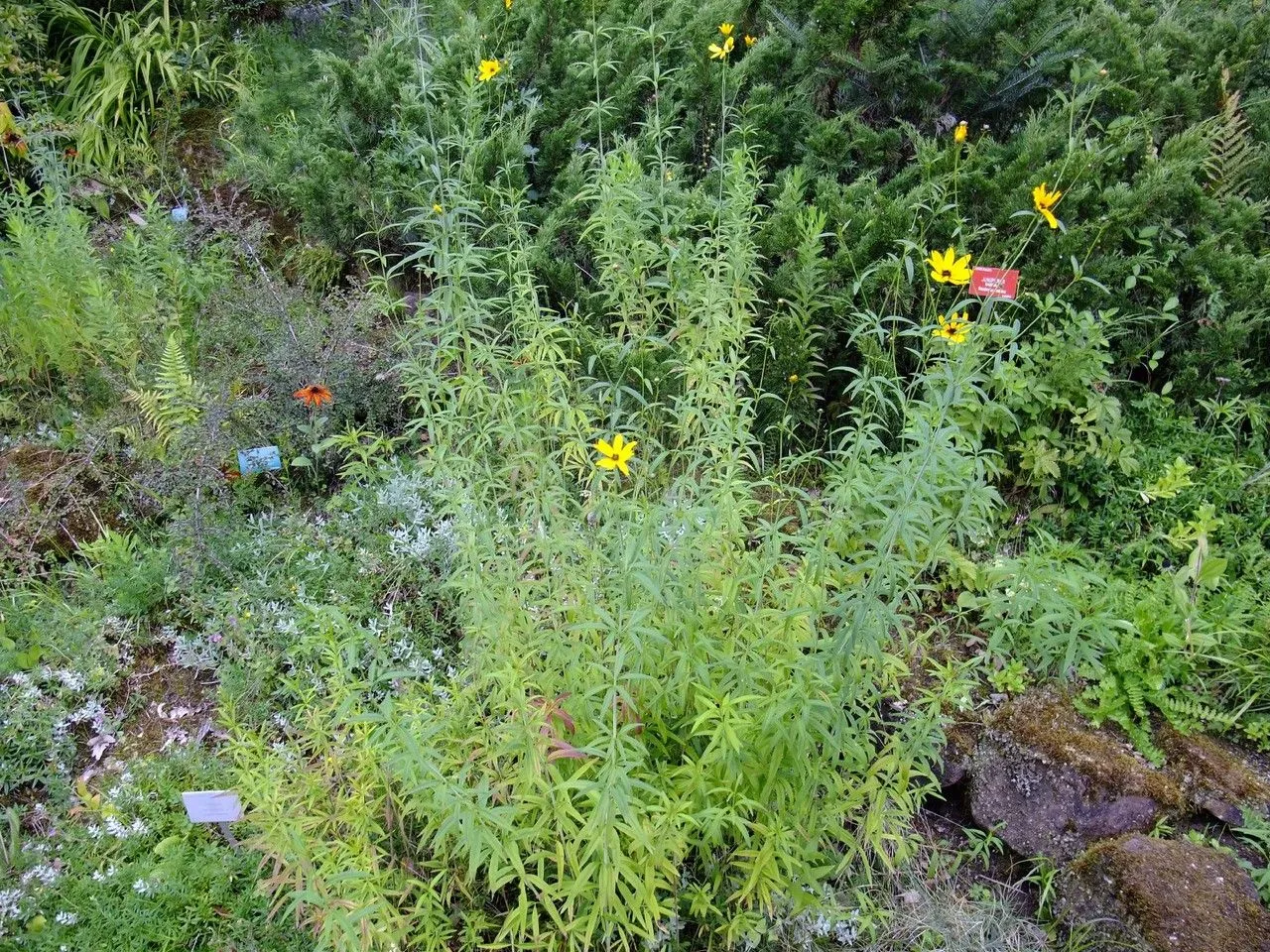
Author: L.
Bibliography: Sp. Pl.: 908 (1753)
Year: 1753
Status: accepted
Rank: species
Genus: Coreopsis
Vegetable: Unknown
Observations: E. Canada to C. & E. U.S.A.
The Tall coreopsis, scientifically known as Coreopsis tripteris, is a charming member of the Asteraceae family. Native to eastern Canada and central to eastern regions of the United States, this perennial plant is known for its impressive height, often reaching up to 8 feet.
Characterized by its slender, erect stems, the Tall coreopsis supports bright yellow, daisy-like flowers, each with a striking central disk that can be either yellow or brown. These flowers typically bloom from mid-summer to early autumn, painting fields and prairies with vibrant hues and attracting a plethora of pollinators, including bees and butterflies.
The foliage of Coreopsis tripteris is equally appealing, featuring lanceolate leaves that are deeply lobed and arranged in pairs along the stem. This distinctive leaf design not only adds to the plant’s aesthetic appeal but also facilitates efficient photosynthesis, contributing to its robust growth.
Thriving in a variety of soil types, the Tall coreopsis prefers well-drained soils and can often be found in open fields, prairies, and along roadsides. Its ability to adapt to different environmental conditions makes it a resilient addition to any garden, particularly those designed for native plant landscaping or pollinator support.
In the context of historical botanical classification, Coreopsis tripteris was first described in 1753, a testament to its enduring presence and botanical significance. The designation “tripteris” is derived from its notable three-parted leaves, further highlighting the plant’s distinctive morphology.
Beyond its ornamental value, the Tall coreopsis holds ecological significance. It provides habitats and food sources for various insects and birds, playing a crucial role in maintaining biodiversity. Its presence in native plant gardens can enhance ecological balance and support the local wildlife.
In summary, the Tall coreopsis is not only a visually striking plant but also an ecologically valuable species, bringing both beauty and biodiversity to the landscapes it adorns.
Eng: atlantic coreopsis, tall coreopsis, tall tickseed, altantic coreopsis, giant coreopsis
Deu: dreifiedriges mädchenauge, hohes mädchenauge
Swe: jätteöga
Fra: coréopsis trifoliolé, coréopsis trifoliolée
En: Tall coreopsis, Tall tickseed, ATLANTIC COREOPSIS, Altantic coreopsis, Giant coreopsis
Da: Høj Skønhedsøje
Fi: Preeriakaunosilmä
Fr: Coréopsis trifoliolé, Coréopsis trifoliolée
De: Dreifiedriges Mädchenauge, Hohes Mädchenauge
Ru: Кореопсис трёхкрылый
Sv: Jätteöga
Taken Sep 23, 2020 by Daniel Richardt (cc-by-sa)
Taken Aug 23, 2021 by kath may (cc-by-sa)
Taken Aug 23, 2019 by Dan Mikal (cc-by-sa)
Taken Sep 9, 2019 by CP Klose (cc-by-sa)
Taken Sep 11, 2021 by Ennazus444 (cc-by-sa)
Taken Jun 16, 2021 by Lenore Roca (cc-by-sa)
Taken Aug 24, 2014 by Tela Botanica − Yoan MARTIN (cc-by-sa)
Taken Aug 23, 2019 by Dan Mikal (cc-by-sa)
Taken Oct 26, 2020 by Kirsty Brown (cc-by-sa)
Taken Oct 26, 2020 by Kirsty Brown (cc-by-sa)
Taken Sep 2, 2015 by EOL − jackpfaffmann (cc-by-nc)
Taken Aug 27, 2015 by EOL − Tim Powell (cc-by-nc-sa)
Taken Sep 1, 2015 by EOL − Robert L Curtis (cc-by-nc-sa)
Taken Aug 27, 2015 by EOL − Tim Powell (cc-by-nc-sa)
Taken Aug 24, 2014 by Tela Botanica − Yoan MARTIN (cc-by-sa)
Taken Aug 3, 2011 by EOL − Ron Thomas (cc-by-nc-sa)
Taken Aug 3, 2011 by EOL − Ron Thomas (cc-by-nc-sa)
Family: Myrtaceae Author: (F.Muell.) K.D.Hill & L.A.S.Johnson Bibliography: Telopea 6: 402 (1995) Year: 1995 Status:…
Family: Rubiaceae Author: Pierre ex A.Froehner Bibliography: Notizbl. Bot. Gart. Berlin-Dahlem 1: 237 (1897) Year:…
Family: Sapindaceae Author: Koidz. Bibliography: J. Coll. Sci. Imp. Univ. Tokyo 32(1): 38 (1911) Year:…
Family: Asteraceae Author: A.Gray Bibliography: Pacif. Railr. Rep.: 107 (1857) Year: 1857 Status: accepted Rank:…
Family: Fabaceae Author: Medik. Bibliography: Vorles. Churpfälz. Phys.-Ökon. Ges. 2: 398 (1787) Year: 1787 Status:…
Family: Aspleniaceae Author: (Cav.) Alston Bibliography: Bull. Misc. Inform. Kew 1932: 309 (1932) Year: 1932…